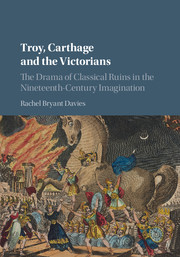 Troy, Carthage and the Victorians
Troy, Carthage and the Victorians Book contents
- Frontmatter
- Contents
- List of Plates
- List of Figures
- Acknowledgements
- Prologue
- 1 Introduction: The Ruins of Troy and Carthage ‘Still Flaming to the Imagination’ in the Nineteenth Century
- 2 ‘An Imaginary Troy’: Homeric Pilgrimage, Topography and Archaeology
- 3 ‘Not Classic, but Quite Correct’: The Trojan War at the Circus
- 4 Freely Perverted from Classic Texts’: The Iliad and Aeneid Burlesqued
- 5 ‘Sitting Among the Bricks of Covent Garden’: Carthage and the Future Ruins of the Nineteenth Century
- Epilogue: Troy and Carthage as ‘A Beacon and a Warning’
- Appendix A List of Burlesques
- Appendix B Select Chronology
- References
- Index
Epilogue: Troy and Carthage as ‘A Beacon and a Warning’
Published online by Cambridge University Press: 03 March 2018
- Frontmatter
- Contents
- List of Plates
- List of Figures
- Acknowledgements
- Prologue
- 1 Introduction: The Ruins of Troy and Carthage ‘Still Flaming to the Imagination’ in the Nineteenth Century
- 2 ‘An Imaginary Troy’: Homeric Pilgrimage, Topography and Archaeology
- 3 ‘Not Classic, but Quite Correct’: The Trojan War at the Circus
- 4 Freely Perverted from Classic Texts’: The Iliad and Aeneid Burlesqued
- 5 ‘Sitting Among the Bricks of Covent Garden’: Carthage and the Future Ruins of the Nineteenth Century
- Epilogue: Troy and Carthage as ‘A Beacon and a Warning’
- Appendix A List of Burlesques
- Appendix B Select Chronology
- References
- Index
Summary
In February 1836, an article entitled ‘The Trojan Horse; or Siege of Troy explained’ appeared in Blackwood's Edinburgh Magazine. Written by the Reverend John Eagles, an art critic and regular contributor to the journal, it makes a strong claim for the pre-eminence of the Trojan War myths in the cultural imagination. Among his emphatic political analysis, bestrewn with multilingual quotations from Homer, Virgil and Dryden, Eagles's analysis of the Trojan War myths usefully encapsulates the many diverse appropriations of Troy and Carthage encompassed by this book. Alternating between a serious and comic approach, Eagles – like my selection of casestudies – embraced the physical ruins of Troy and their significance for a range of arenas including politics and historiography, as well as the implications for contemporary Britain of the succession of cities and empires embodied by Troy, Carthage and Rome. In particular, Eagles aimed to ‘recover for the ancient Homeric and Virgilian almanacks their legitimate Troy-weight’. His essay – which was published the year after Auldjo's Journal corroborated the Bunarbashi theory of Troy's location, three years after The Giant Horse at Astley's imagined a fantastical Greco-Roman Troy and hot on the heels of a number of poems concerning Marius in Carthage plotting his revenge on Rome – was a clear product of its time. Conceived as ‘a protest against the wholesale cutting and slashing, maiming and mutilating, that the wondrous relics of antiquity are subjected to in the German schools of historical reform’, it shared its motivation with many of the Homeric pilgrims we met in the first chapter. Crucially, however, Eagles's passionate testament to the cultural centrality of the Siege of Troy also pointed ahead to debates which, as we have seen, would become vital for understanding the changing significances of Troy and Carthage. Well before excavations at Hisarlik in the 1870s validated the ‘proof of the spade’ and linked biblical cities with those of classical epic, Troy had become evidence for the ‘universality and unchangeableness of the features of human nature’.
- Type
- Chapter
- Information
- Troy, Carthage and the VictoriansThe Drama of Classical Ruins in the Nineteenth-Century Imagination, pp. 339 - 346Publisher: Cambridge University PressPrint publication year: 2018


